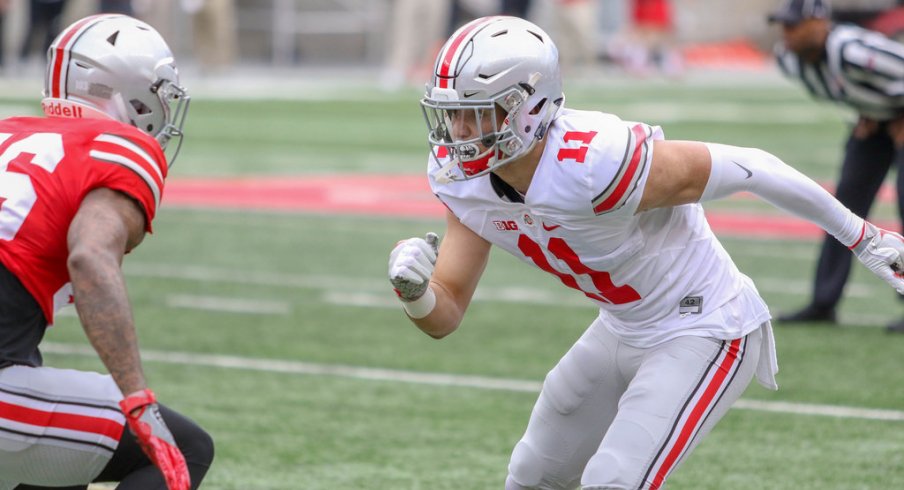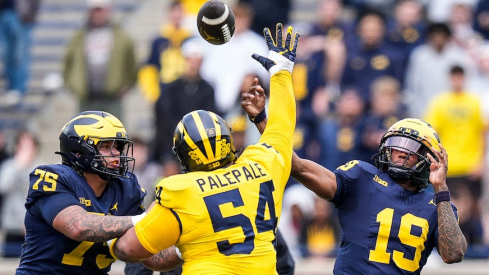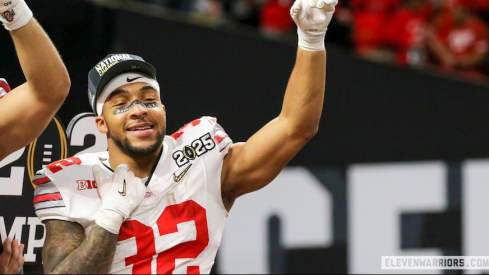With much of the focus of Ohio State’s 2018 spring practice has been on WHO, here at Film Study, we’re far more concerned with the HOW.
In the Buckeyes’ first public appearance of the post-J.T. Barrett era, they seemed to move the ball at ease, even as established playmakers like J.K. Dobbins, Mike Weber, and K.J. Hill saw little or no playing time during the inter-squad scrimmage. However, while much of the focus has been on who will ultimately replace Barrett as the next starting quarterback in Columbus, fans were also treated to the unveiling of how the scarlet and gray offense will operate, regardless of who is under center.
Though each of the three quarterbacks supposedly competing for the job have different skill sets, the playbook of Kevin Wilson and Ryan Day appears to be set up to allow any of Joe Burrow, Dwayne Haskins, or Tate Martell to succeed. Given the latter’s relative lack of experience, though, we saw far more running with him in the game, as freshman tailback Master Teague carried the ball a game-high 14 times, most often when lined up next to Martell. While the majority of Teague’s carries came from the base tight zone run and its close cousin, the split-zone run, there appeared to be new wrinkles associated with those concepts.
As has always been the case in Urban Meyer’s offense, the quarterback still had the option to pull the ball based on his read of an unblocked defender. However, given that not all the quarterbacks feature the same kind of running ability as Barrett or Martell, the OSU coaching staff added relief pass routes to nearly every running play called last Saturday, giving each signal-caller the option of throwing outside should the numbers be there.
These Run-Pass Options (RPOs) are not new in the OSU offense, as they appeared with far more frequency last fall after Wilson and Day took over. However, without Barrett in the backfield, we saw them attached to new concepts, such as the Counter-Trey concept that had largely been a designed run for the quarterback during Meyer’s first six seasons in Columbus.
But while Most of Martell’s pass attempts came on relief routes attached to run plays, Burrow and Haskins did most of their work from the traditional dropback passing game. Initially, we saw many of the same concepts we saw last fall, with Parris Campbell and Demario McCall taking short crossing routes for solid gains in the Mesh concept (one of Day’s favorites).
As the 2017 season wore on, though, opponents began to anticipate the Mesh concept, despite the number of formations and personnel groupings from which it could be run, meaning the Buckeyes needed to find other intermediate crossing routes to attack the middle of the field. To that end, it appears they’ve added a number of concepts like Shallow Cross and Drive that create a high-low stretch of the linebackers in the middle of the field.
These concepts appear to have been well matched with concepts on the outside like a fade/out route combination (known as Ohio to some coaches), which gives the quarterback an easy read from the outside-in, working horizontally across the field to find an open man.
The biggest takeaway from the afternoon may have been the manner in which Day and Wilson disguised another favorite from last fall, the three-vertical downfield concept known as Saints. Made famous by Day’s mentor, Chip Kelly, Saints (called Bubble Y-Over in the playbook) is a simple concept in which a bubble screen is paired with a vertical route along the boundary to create a high-low stretch on the cornerback in that area. If both routes are covered, a deep crossing route or post (depending on the coverage) should be open over the middle of the field, followed by a backside post from the final receiver.
If the running back releases out of the pocket, often after a play-action fake, he heads to the side opposite the bubble screen, meaning there are three deep routes and a receiver in either flat. As we saw Saturday, though, there are a number of ways to build such a route combination.
The Ohio concept was used a number of times to create the initial high-low stretch, giving the quarterback an easy five yards if the defense plays the same man coverage we saw much of the afternoon from Greg Schiano’s troops. Similarly, we saw the Fade-Smash concept that became so popular last fall, as unsuspecting safeties in pattern-matching schemes all of a sudden found themselves in a one-on-one contest with a talented slot receiver downfield. If the corner cheats to help the safety, though, the outside receiver’s hitch route is left wide open.
While McCall proved quite difficult to cover on the deep middle crossing route, big receivers like Binjamin Victor and Jaylen Harris had their way with smaller defenders left on islands as the Saints concept spread them out across the field. These personnel advantages were exploited most often by the Gray team, who averaged a whopping 9.3 yards-per-pass attempt on the afternoon, with both Burrow and Haskins connecting on deep balls over 40 yards.
However, not everything went perfectly for the Buckeye offense. Though both Brady Taylor and Josh Myers played well as they vie to replace Billy Price at center, Jamarco Jones’ potential successor at left tackle seemed to struggle. Though he’d been expected to move over to the left, Isaiah Prince started the day back at his familiar spot at right tackle, leaving Thayer Munford to protect the blind side. Munford, however, seemed to have a rough go of it in pass protection.
While few can blame the sophomore for struggling to slow down perhaps the best pass rusher in America, Nick Bosa, Munford also struggled to stay in front of fellow sophomore Chase Young, who practically set up camp in the backfield. Young claimed to have had ‘six or seven’ sacks had he not been forced to slow down for the quarterbacks wearing black, ‘no-contact’ jerseys.
Young wasn’t perfect in the Scarlet and Gray game, however, as he and many of his teammates on the defensive side of the ball struggled to properly fit the run game, allowing Teague and others to find open running lanes. While Bosa and fellow starters on the defensive line like Dre’Mont Jones and Robert Landers saw little playing time, the second and third units struggled to mesh with the new linebacking corps of Justin Hilliard, Malik Harrison, and Keandre Jones.
The most egregious such example was Mike Weber’s 63-yard scamper in the second quarter. While his move to shake the safety in the open field may have left jaws agape, that juke only happened because Young failed to fill his gap properly.
When the left tackle, Munford, blocks down inside, leaving Young unblocked, the end should have quickly stepped inside to replace him, taking away the natural gap in the space between them. However, Young can’t help but attack upfield, taking himself right out of the play as the ball is handed off.
But once the ball was given to Weber and the Y sealed the edge of the gap on this split-zone run, Hilliard wasn’t there to clean up Young’s mistake, as he got caught too far inside to fill his B-gap responsibilities. Though a number of mistakes can be attributed to the typical Spring game issue of mismatched personnel groupings playing together, fundamental breakdowns like the ones seen above have nothing to do with unfamiliarity of one’s teammates.
Given the uncertainty surrounding the team's most important position, it must've calmed fears to see the top two contenders for the job play so well. Not only were they successful in their most important job interview to date, they were set up to succeed by a coaching staff that has tailored the playbook to fit either player.
Yet while many have compared this team to the uber-talented 2015 squad, thanks not only to a quarterback competition but to a Bosa at the peak of his powers and an all-world running back ready to take his game to the next level, the reality is far different. That team featured unprecedented depth throughout the roster, with players like Curtis Samuel, Gareon Conley, and Chris Worley playing supporting roles after already proving capable of contributing the year prior.
The second-level depth on the 2018 roster is far more unproven and, thus far, less prepared to step in should a top-tier player go down, making the margin for error that much thinner for a team expected to contend for a national title. While there's plenty of time to improve between now and September 1st, there's plenty of work that must be done to keep this team from suffering an unexpected loss like the one seen in Iowa City last fall.



